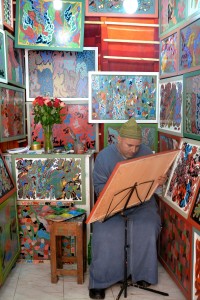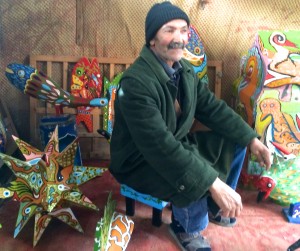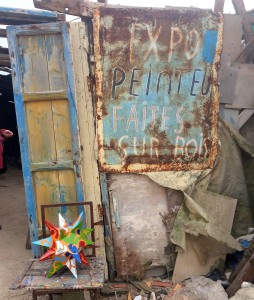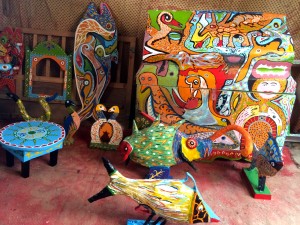The port city of Essaouira, on Morocco’s Southern Atlantic Coast, is known for its white-washed walled medina (old city), fabulous seafood from its working port, a windswept sandy beach great for watersports and swimming and its annual music festivals, which reflect its culturally diverse past. Essaouira is also known as a town of artists – both indigenous and international – who are inspired by the relaxed atmosphere, creative environment and fabulous light. The streets of the Essaouira medina are lined with boutiques and galleries, which present plenty of opportunities for purchasing locally produced pieces.
One famous gallery is the Galerie Damgaard near the clock tower. Danish collector Frederic Damgaard is credited with bringing the naive art of Swiris (native Essaouirans) to a wider, global audience. In the 1980s, he spotted the potential of self-taught local artists, many of whom were fishermen, farmers or members of the local Gnaoua brotherhoods of Muslim sufis who practice music, song and trance. Damgaard likened the style of these autodidactic artists, working in two and three dimensions, to the increasingly popular indigenous art of other cultures. Today, the work of the better-known artists such as Mohammed Tabal, Aberrahim Harabida and Fatima Ettalbi are regularly exhibited in Essaouira and internationally.
For those who seek direct contact with lesser-known artists, it is possible to visit their makeshift art studios in Essaouira’s quartier industriel (industrial quarter). The best time to visit is during the weekly Sunday flea market, known as the joutiya (from the French, jeter, to throw or discard), when an art tour can be combined with a rummage through the second-hand and antique treasures on the many stands lining the streets. You will also see junk stalls and architectural salvage yards where those restoring riad townhouses in the medina might find a period piece or a rare gem.
Working with found materials, salvaged boards and other objects ripe for up-cycling, the Joutiya artists have their studios in unpaved alleyways running parallel to the ocean. They are surrounded by the materials of their craft: broken tiles, abandoned furniture, carpenter’s off cuts, shells and pebbles.
Although you can find the work of the joutiya artists such as Abdelaziz Baki, Ali Maimoune and Asmah Ennaji in the medina, they are happy to welcome you in to their studios, where they exhibit the full range of their work. In Baki’s studio you will find brightly coloured sculptures of fantastical beasts – half bird, half fish or part man, part animal. He also decorates small pieces of furniture in his inimitable style featuring eyes (the evil eye is common theme in Islamic and Jewish cultures) and dots reminiscent of Aboriginal art. Asmah’s paintings feature solemn-faced portraits of doe-eyed subjects, sometimes so tightly crammed into the frame as to be disturbing. Others seem positively benevolent and gentle. Look out also for Filali, whose naive portraits of local characters, simply portrayed on chipboard, are comical and appealing in their lack of perspective or conformity to accepted norms. His portrayal of marrying couples – sometimes looking a little reluctant – make a quirky gift.
If you aren’t in town on a Sunday, the newly renovated Centre Artisanal (Artisans Center, opposite L’Heure Bleue) is also a great place to discover local arts and crafts.
Written by Lynn Sheppard
Lynn Sheppard has lived in Essaouira, on Morocco’s Atlantic Coast for more than 2 years, supporting local non-profits, writing and becoming an expert on all things Swiri (ie. Essaouiran). She blogs at Maroc-phile.com and for other travel industry clients.
For more information about Essaouira Art at the Joutiya Market or an Essaouira Tour






